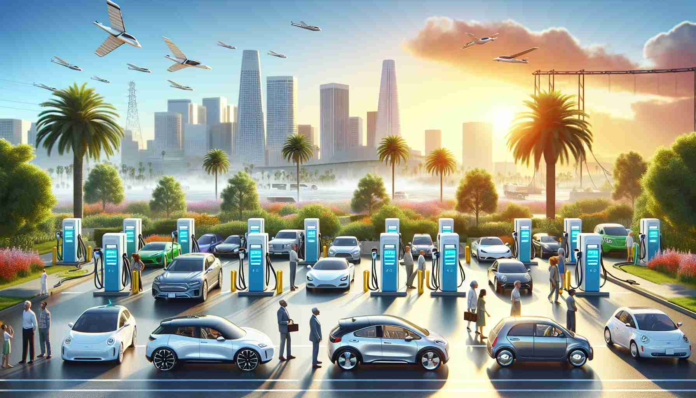A recent study by scientists from the University of California, Berkeley, has evidenced a drop in carbon dioxide emissions in the San Francisco Bay Area, attributing this positive change to the rise of electric vehicles (EVs). This development reflects the state’s broader goal of reaching net zero emissions by 2045.
Summary: California’s push for environmental reform is revealing tangible results as the adoption of electric vehicles contributes to a steady decrease in CO2 emissions. Enhanced by sensor networks monitoring atmospheric conditions, the state is gradually progressing towards its net zero ambition, despite the need for an increased reduction rate.
Ronald Cohen, a chemistry professor at the University of California and lead author of the study, points to the usage of a comprehensive sensor network that has documented a consistent 1.8 percent annual reduction in CO2 emissions over five years. This decrease is notably linked to the higher prevalence of EVs in the area, supported by the fact that nearly 5% of all vehicles in the Bay Area are electric or hybrid.
Cohen illustrates that while the reduction speed remains below the required pace to meet the state’s 2045 goal, this decrease is a substantial “down payment” towards the future target. His study underlines the effectiveness of policy measures and indicates that with continued effort and innovation in technology and infrastructure, the goal could become attainable.
California leads the United States in its environmental initiatives, as it commits to prohibiting the sale of new gas-powered vehicles by 2035. Recognizing that the Bay Area’s results may not replicate uniformly across less progressive regions, Cohen remains optimistic. Expanding the sensor network to other cities including Los Angeles, Providence, and Glasgow, he hopes to further demonstrate that strategic policy interventions can yield significant environmental benefits.
The push towards electric vehicles (EVs) is not unique to California—it’s a fast-growing global trend. With concerns over climate change and greenhouse gas emissions, countries worldwide are investing in the EV market. Not only are EVs a tool for reducing emissions, but they also represent a rapidly advancing sector laden with economic opportunities.
Industry and Market Forecasts
The electric vehicle industry is projected to grow exponentially in the coming years. Market research firms like BloombergNEF forecast that EV sales will surpass internal combustion engine (ICE) vehicle sales by 2038, with the majority of sales in developed countries potentially becoming electric by the mid-2030s. This growth is spurred by government incentives, falling battery prices, and increasing consumer demand for sustainable products. Improvements in technology are also leading to longer driving ranges, faster charging times, and generally more appealing and diverse EV models.
Issues Related to the Industry
Despite the optimistic trajectory, the EV industry faces numerous challenges. The availability and distribution of charging infrastructure are uneven, often described as a barrier to adoption, particularly in rural or underprivileged areas. Moreover, there are concerns about the environmental impact of battery production and disposal, as well as the need for a more sustainable lifecycle for EVs. Raw material sourcing for batteries, such as cobalt and lithium, raises ethical and environmental concerns that the industry will need to address as it scales up production.
Another significant issue is the integration of EVs with existing electricity grids. As EV adoption rises, the demand on power grids will increase, necessitating substantial upgrades to infrastructures. Energy generation will need to shift further towards renewable sources to ensure that the benefits of EVs are not offset by fossil-fuel-based electricity production.
For those interested in the broader economic and policy implications of the EV market and sustainability efforts, related information can be sourced from credible industry analysts and environmental resources. Examples would be the International Energy Agency (IEA) link name, which offers data and forecasts on EV adoption and renewable energy integration, or the Environmental Protection Agency (EPA) link name, which provides resources on policies and regulations shaping these industries.
In conclusion, the findings from the University of California, Berkeley, indicate a hopeful trend in emissions reductions facilitated by increased EV usage. Yet reaching and sustaining larger goals will depend on a myriad of factors, including technological advances, infrastructural overhauling, battery lifecycle management, and equitable policy frameworks to guide the transition to a more sustainable future. As the state of California endeavors to reach its net-zero ambition, its policies and initiatives may serve as a blueprint for regions around the globe striving for similar environmental improvements.

Natalia Toczkowska is a notable figure in digital health technology, recognized for her contributions in advancing telemedicine and healthcare apps. Her work focuses on developing innovative solutions to improve patient care and accessibility through technology. Toczkowska’s research and development in creating user-friendly, secure digital platforms have been instrumental in enhancing the effectiveness of remote medical consultations and patient monitoring. Her dedication to integrating technology in healthcare has not only improved patient outcomes but also streamlined healthcare processes, making her a key influencer in the field of digital health innovation.

